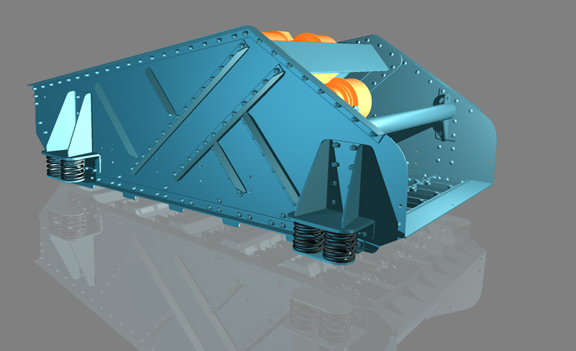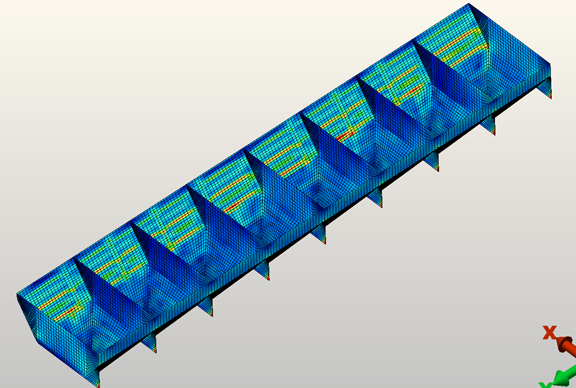April 29, 2011


Andrew Sears, a mechanical engineer from Balzer Pacific, knew analysis took time and patience. The last time he ran analysis on the design of a dewatering screen, used in concrete and asphalt processing industries to separate sand and dirt from rocks, it took his Dell Precision T3400 workstation (8 GB RAM, 64 bit OS, Intel Core2 Duo processors) roughly eight hours to complete the job.
The purpose of the analysis was to figure out the ideal plate thickness, the configuration that satisfies the required factor of safety with the least amount of steel.
“Length and width are parameters that we would change if we could,” explained Sears, “but more often than not, [the screen] has a target volume it needs to hold, so these outer parameters stay unchanged. We have tried widening the screen too, to see if we could make it lighter.”
Ultimately, Sears and his colleagues determined that the plate thickness was the best variable to experiment with. So Sears came up with four design options with varying plate thickness. The analyses, he estimated, would take his computer roughly two days. Then he remembered a feature in Autodesk Inventor he’d heard about.
At the time, the Inventor Optimization feature was still a technology preview, downloadable from Autodesk Labs. (The feature is set to become part of Autodesk Inventor 2012.) Autodesk describes it as “a simple, web-based simulation tool to help an engineer minimize weight and cost while improving product safety.” For someone like Sears, the software could perform multiple simulations behind the scenes in the cloud, leaving the CPU cores in Sears’ own machine free for whatever additional software he needed to run.
With the utility installed, Sears can upload all four design scenarios to the remote server, specify the variable parameters and the desired factor of safety, then collect the results when the run is complete. So he did (“just for giggles,” as he put it).
“It brought back the results in an hour and a half,” recalled Sears. That’s because the remote server that did the number crunching for Sears is powered by many more computing cores than a typical PC.
Somewhat bemused, Sears discovered he had over-designed the screen. That’s understandable. “In this industry, people tend to think bigger is better,” acknowledged Sears. The client, he pointed out, often thinks thinner plates are not strong enough to withstand the load, stress, and vibration they’ll be subjected to. The optimal design suggested by the software contained far less steel than Sears’ initial version.
“Using the Optimization function is easier than using other analysis tools,” observed Sears, who also uses Autodesk Algor (acquired by Autodesk in December 2008). “It’s straightforward. The way that it’s laid out, you click the first button, click the next button, click the third, and it’s ready to go. Not a whole lot of extra steps, no complicated settings involved.”
Sears would be the first to admit that the design of a dewatering screen is not exactly the stuff of industrial espionage. “But we are doing things that others companies might like to get their hands on,” he said. That, of course, made him wonder about the IP security risk involved in uploading his design to a remote server, currently maintained by Autodesk.
Eventually he discovered just how secure the data was when he needed to contact Autodesk tech support with a question.
“Can you send us your model?” asked the support technician.
“What do you mean? I uploaded it to your [Optimization] server. Don’t you have that?” Sears replied in dismay.
It turns out, the built-in security protocols don’t discriminate. Even Autodesk officials can’t easily access the bits and bytes Sears uploaded. That, for better or worse, convinced Sears that cloud-hosted optimization was secure enough for his peace of mind.
Autodesk has hinted it plans to augment its best-selling desktop software titles with value-added web services. Inventor Optimization feature is one such example. While many of these are available for free during preview and test phases, as they become mature, robust utilities, the company will undoubtedly be looking for ways to generate revenues from them. So far, Autodesk has not revealed how it plans to charge customers for accessing these services. So, at least for the time being, Inventor Optimization remains free, much to the delight of Sears.
Subscribe to our FREE magazine, FREE email newsletters or both!
About the Author
Kenneth Wong is Digital Engineering’s resident blogger and senior editor. Email him at [email protected] or share your thoughts on this article at digitaleng.news/facebook.
Follow DERelated Topics






